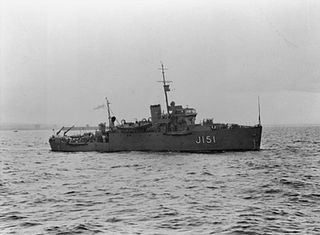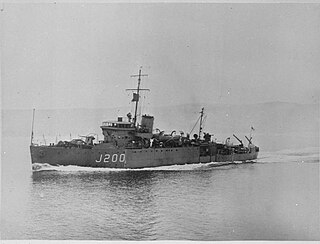HMS Rye (J76) was a Bangor-class minesweeper built for the Royal Navy during the Second World War.

HMS Hythe was a Bangor-class minesweeper built for the Royal Navy during the Second World War.

HMS Clacton was a Bangor-class minesweeper built for the Royal Navy during the Second World War.

HMS Ardrossan was a Bangor-class minesweepers built for the Royal Navy during the Second World War.
HMS Felixstowe was a Bangor-class minesweepers built for the Royal Navy during the Second World War.

HMS Cromer was a Bangor-class minesweepers built for the Royal Navy during the Second World War.
HMIS Kathiawar (J155) was a Bangor-class minesweeper built for the Royal Navy, but transferred to the Royal Indian Navy (RIN) during the Second World War.
HMIS Baluchistan (J182) was a Bangor-class minesweeper built for the Royal Navy, but transferred to the Royal Indian Navy (RIN) during the Second World War.
HMIS Khyber (J190) was a Bangor-class minesweeper built for the Royal Navy, but transferred to the Royal Indian Navy (RIN) during the Second World War.
HMIS Rohilkhand (J180) was a Bangor-class minesweeper built for the Royal Navy, but transferred to the Royal Indian Navy during the Second World War.
HMIS Kumaon (J182) was a Bangor-class minesweeper built for the Royal Navy, but transferred to the Royal Indian Navy (RIN) during the Second World War.
HMIS Carnatic (J182) was a Bangor-class minesweeper built for the Royal Navy, but transferred to the Royal Indian Navy (RIN) during the Second World War.
HMIS Rajputana (J197) was a Bangor-class minesweepers built for the Royal Navy, but transferred to the Royal Indian Navy (RIN) during the Second World War.

HMIS Orissa (J200) was a Bangor-class minesweepers built for the Royal Navy, but transferred to the Royal Indian Navy (RIN) during the Second World War.
HMIS Bihar (J247) was a Bangor-class minesweeper built for the Royal Navy. It transferred to the Royal Indian Navy (RIN) during the Second World War.
HMIS Konkan (J228) was a Bangor-class minesweepers built for the Royal Navy, but transferred to the Royal Indian Navy (RIN) during the Second World War.
HMIS Deccan (J129) was a Bangor-class minesweepers built for the Royal Navy, but transferred to the Royal Indian Navy (RIN) during the Second World War.
HMIS Malwa (J55) was a Bangor-class minesweepers built for the Royal Navy, but transferred to the Royal Indian Navy (RIN) during the Second World War.
HMIS Oudh (J245) was a Bangor-class minesweepers built for the Royal Navy, but transferred to the Royal Indian Navy (RIN) during the Second World War.
HMS Lyme Regis was a Bangor-class minesweeper built for the Royal Navy during the Second World War.






